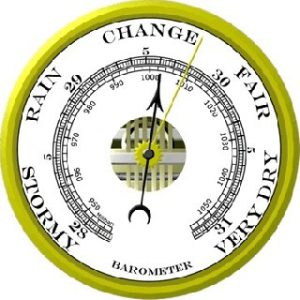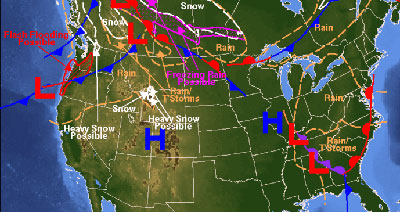What drives a deer? The answer is breeding, safety, eating, and drinking. No matter what the weather does, deer still have to execute their daily routines in order to survive. Does weather affect the daily activity level of deer? You better believe it does.
Whitetail deer are expert survivalists. Their ability to read their surroundings and the weather is a matter of life and death. There are times when they hunker down and don’t move too much and there are times when their activity levels increase and they are on the move for a larger percentage of the day. Why is this? Is this predictable? Lets take a look at some important factors on whitetail deer and weather.
Temperature’s affect on whitetail deer
High temperatures
In the same way that the weather affects us, it affects the whitetail deer as well. Our activity levels go down as the temperature goes up and that is for a good reason. Just like us, deer get uncomfortably hot and will seek cooler temperatures. Deer will limit their activity to conserve their precious energy and to maintain their hydration level. Often times deer will turn nocturnal so they can operate during cooler temperatures.
They also bed down in a cooler part of their range. Remember that cold air sinks to the lower levels of the land. To find these AC seeking deer, look for shaded ravines and creek bottoms that will have a larger concentration of cooler air. Walk your hunting property during the summer and make notes of where the lowest temperature readings are found. These spots maybe a good area to hunt when the weather is hot.
Low temperatures
Low temperatures spike deer activity. Deer know that when the daily average temperatures start to fall, its time to fatten up for winter and the upcoming rut. Bucks will forage on acorns, corn, beans, and whatever other high fat food they can come across. Their goal is to build up enough body fat (stored energy) to ensure their survival during the physically taxing rut and extreme cold temperatures of winter. Does will also fatten up for survival and to ensure they have enough stored energy to sustain a successful pregnancy.
Will super extreme cold conditions hamper deer activity?
I do not believe so. I say this because I have witnessed spiked activity on days which I should have stayed home instead of hunting. Deer have to eat no matter what and when it is dangerously cold they will die if they remain dormant.
I have been in the treestand when it was -35 with the windchill and saw a record number of deer. It was so cold that when I looked through my rangefinder at these deer, my closed eye’s lashes froze to each other and I couldn’t open my eye. My goal, that last day of the season hunt, was to last 3 hours in the treestand and I did. The amount of activity was impressive.
Barometric pressure and it’s affect on whitetail deer
If you were camping in a tent and saw and smelled a storm coming in, would your activity level increase before and after the storm? Sure it would. Deer aren’t any different.
Whitetail deer have an innate ability to sense upcoming changes in the weather. They can sense the barometric changes in the atmosphere and adjust their activity level accordingly. By definition, atmospheric or barometric air pressure is the force per unit of area exerted on the Earth’s surface by the weight of the air above the surface.(1). High pressure system are typically clear and calm while low pressure systems contain nasty weather.
When the deer sense an incoming low pressure system, their activity level and feedings increase. They know their defenses are going to be limited during a low pressure system and they want to be prepared for an extended period of inactivity.
When the low pressure system is leaving, deer spring back into action and make up for the down time that was a result of the bad weather of the low pressure system. The spike in a whitetail deer’s activity level typically occurs when the barometer is rising or falling and is in between 29.80 and 30.29 on the barometer. Here is some more info on high and low pressure systems.(2)
High and low pressure systems
High pressure systems have the following characteristics:
- High pressure systems have readings of over 31 on the barometer.
- They are contain hot or cold weather depending on their origination.
- Due to the high pressure, clouds dissipate and skies are normally clear under high pressure conditions.
- Winds blow away from a high pressure system, so an increase of wind may indicate that a high pressure system is on its way.
- Winds are normally calm during a high pressure system.
- Weather is normally dry during a high pressure system.
Low pressure systems have the following characteristics:
- Low pressure systems have readings below 29 on the barometer.
- Low pressure systems are associated with high winds, warm air, precipitation, and clouds.
- Nature’s nastiest storms are the direct result of low pressure systems.
- The air is moist during a low pressure system.
Wind and it’s affect on the whitetail deer
The wind can be the whitetail deer’s best friend or its worst enemy. Deer prefer a slight to moderate wind in order to scent what may be up ahead. They use the wind to located other deer, avoid predators, and to locate food. Deer will often bed down facing down wind so they can watch for predators and other deer while being able to smell what’s approaching from behind.
Wind can also dictate what part of a woods the deer will concentrate their activity. When a protected woods (forest preserve) is surrounded by private property, deer will often only habitat the down wind area of the private property. This will give them the advantage over any dangers that exist outside the comforts of their sanctuary. If you are fortunate enough to hunt a property that borders a sanctuary, you may have noticed more activity when the wind was not in your favor.
Strong winds will decrease deer activity due to their senses being compromised.
When the wind is strong, over 17 miles per hour, their defenses suffer:
- Scents whiz by faster and are tougher to register so their sense of smell is impaired.
- Wind blown branches and weeds dance around limiting their ability to spot movement from predators.
- High winds drown out sounds and limit their hearing range, crippling their sense of hearing.
While deer still have to maintain their daily routine for survival, their activity levels are low during high winds to make up for their weakened senses.
Rain
Deer may or may not move much during the rain depending on a couple of factors. If the rain is a light rain, it may not affect them at all. If the rain is a torrential downpour or is accompanied by high winds, deer will most likely wait the storm out due to their senses being compromised. Remember high winds and a pounding rain will cripple their sense of hearing, their sense of smell, and their vision, leaving them hesitant to move into a possibly vulnerable predicament with predators.
During light rains and the time after a rain shower work to their advantage. The moisture filled air opens their already powerful nasal cavities and their sense of smell becomes heightened. This intensified sense of smell puts them at ease and they are more confident to become active. This may be one reason why after a storm deer activity increases.
Daylight and moonlight
Daylight
Although not technically weather, the amount of light present during any given day does influence the whitetail deer. The main trigger of the whitetail deer’s rut phase is the daily decrease in daylight. This decrease in daylight which induces physiological and behavioral changes in deer is called photoperiodism.(2) Photoperiodism coincides with falling temperatures and spikes testosterone levels in bucks, estrogen levels in does, and the breeding phase begins. After many years of research, photoperiodism is considered the main cause of rut activity in whitetail deer.
Moonlight
According to Charles Alsheimer in his book, Strategies for Whitetails, the second full moon after the autumn equinox is called the “rutting moon” and is what triggers the rutting phase of whitetail deer. This moon changes the deer from a seeking phase to a chasing phase which results in breeding that takes place during the next new moon and few days that follow.


